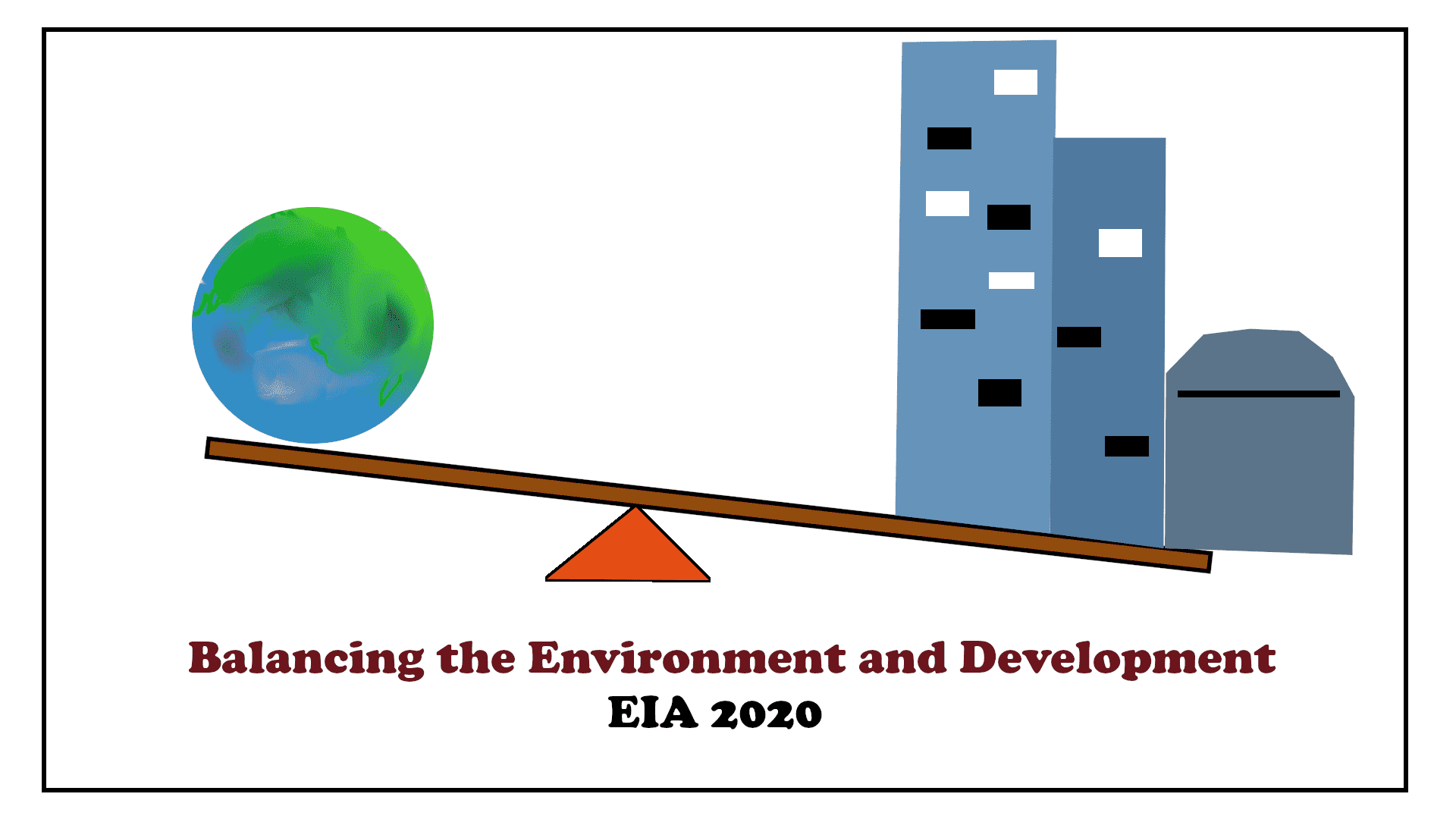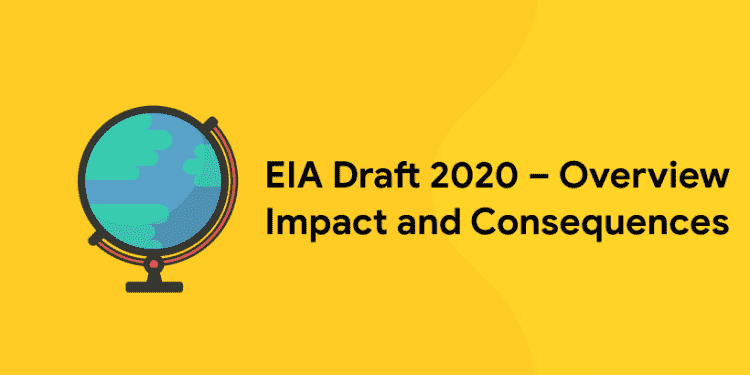Table of Contents
The whole nation is discussing the draft of EIA 2020 and its impact and consequences on the environment. The Ministry of Forestry and Environment, Government of India has issued the Environment Impact Assessment draft (EIA) which is there at the phase of receiving public response. It is a matter of protest for some section of people and it is a matter of encouragement for some section of people. Some consider it as a death line to the environment and some consider it as a key to future development. Here let us take a look at the composition overview, history, impact and consequences of the new Environment Impact Assessment Draft 2020 with comparison to the previous EIA 2006.
What is EIA? All You Need to Know
EIA is a set of rules that has been issued by the ministry of forestry and environment according to the environment protection rules of 1986. The UN Stockholm conference on Human Environment which took place in June 1972 became a game changer in policy decisions and law making in the perspective of environmental concern. India was also a member at that conference. From light of the decisions and initiatives of the Stockholm conference India has enacted a law named Environment Protection Act in 1986. The section 6 and 25 of Environment Protection Act enabled the central government to pass certain rules for the implementation of the particulars said in the above act. Thus, the central government issued Environment Protection Rules of 1986. According to the sub rule (3) of rule 5 of environment protection rules the EIA rules has been drafted and notified in 2006. The 2006 rules have been revamped and issued another draft in 2020 which is there at the stage of receiving public responses.
EIA means Environment Impact Assessment. For any project or industry or activity to carry on, they must obtain some clearances from the government. One of the clearances is environment clearance. The environment clearance is given to the project by analysing the impact of the project on the environment. If the project is not received an environment clearance it cannot be started (as of yesterday). The procedure which analyses the impact on the environment due to this project, the particulars need to carry out during the process, the essentials required for the clearance all are described under EIA notification. In short EIA is a procedural rule to implement the Environment clearance to a project or industry in order to carry out a balance between the development and environment protection.

EIA 2006 v/s EIA 2020 Draft – A Quick Overview
1: Who was the first woman President of India?
| EIA 2006 | EIA 2020 Draft | |
| Implementation Body | Not a well-Defined Body | Highly Defined Body with Decentralisation. |
| Categorisation | Strict Category | Diluted Category |
| Process of Giving Clearance | Screening – Scoping – Public Consultation- Appraisal | Scoping – Public Consultation – Appraisal |
| Public Hearing | 30 Days of notice time | 20 Days of Notice time |
| Validity of Prior Environment Clearance | Mining Project = 30 years
River valley project = 10 years All other project = 5 years |
Mining Project = 50 years
River Valley project = 15 years All Other projects = 10 years |
| Post Environment Clearance Monitoring | Half yearly compliance reports
(once in 6 months) |
Yearly compliance report
(once in 12 months) |
| Violation of Prior Environment Clearance (prior EC) | No conciliation methods specified
(Court verdict is there that no need of giving a chance of post environment clearance)
Violation can be reported by any persons |
Notification itself specifies chances for Post Clearance by the Appraisal Committee
Violation can only be reported by Project Proponents, Government Authority, Appraisal committee, or any regulatory authority. |
| Projected excluded from Prior EC | No Projects | 40 Projects |
Now let us look into the above particulars in detail to have a clear idea about all these things.
Download Entri for Current Affairs Updates
Free UPSKILLING Courses!
Take your first step toward mastering in-demand skills, acing interviews, and securing top-tier jobs with Entri's free upskilling courses.
Start Learning!Implementation Body
This is one of the positive sides of the EIA Draft 2020 where the EIA 2006 lacks to have. The EIA 2006 says about two bodies, one a central body and another a state body. The central body will have a central expert appraisal committee (EAC) and the state expert appraisal committee (SEAC). The projects have been classified into category A and category B according to the schedule of EIA 2006. The projects described in category A need a clearance form the EAC and projects in category B need a clearance from SEAC.
In the EIA 2020 draft the composition of the central and state body have been specified very descriptively. Who is the chairman and members of the body? What should be their qualification? What should be their tenure? All these particulars are described in the EIA 2020 draft which we cannot see in the EIA 2006. In addition to the state level appraisal committee the EIA 2020 constitutes a provision for the establishment of District level Appraisal Committee which can be considered as a good initiative of decentralisation.
Process of Giving Clearance
The projects specified in the category A needs a clearance from the central appraisal committee (EAC) after a detailed study of the impact and consequences of the project on the environment. But for the category B clearance is obtained from the State Level Appraisal committee (SEAC). The process is Screening – Scoping – Public Hearing – Appraisal Committee Report. In the screening stage the SEAC classifies the project into category B1 and category B2. The projects in B1 require a detailed study and further research regarding the environmental impact and consequences and will go though scoping public -consultation and appraisal committee report. But for the category B2 it will go for a direct appraisal committee report since it does not need further study.
According to the EIA 2020 Draft things are different. The categorisation is not just category A and Category B instead it is Category A, Category B1 and Category B2. The schedule itself specifies what is category B1 and Category B2. Therefore, there is no screening process for determining whether the project requires a detailed study or not. The schedule itself specifies what all are needed, specified study and what all are needed not. One may think it as a very good initiative of strictness but when we look into the categorisation changes, we may see some concerns.
Categorisation
The categorisation has been changed utterly in EIA 2020 from EIA 2006. EIA 2006 had a strict categorisation or the range of categorisation was wide. But EIA 2020 the range of categorisation is too small. The EIA 2020 categorisation is too liberal in the sense it is very easy to start a project for the project initiators. For example,
EIA 2006 effect on categorisation
| Project | Category A | Category B |
| Mining of minerals. | ≥ 50 ha. of mining lease area in respect of noncoal mine lease. | <50 ha ≥ 5 ha .of
mining lease area in respect of non-coal mine lease. |
EIA 2020 Draft effect on Categorisation
| Project | Category A | Category B1 | Category B2 |
| Mining of Minor Minerals | >100 ha. of mining lease area | > 5 ha. and ≤ 100 ha. of mining lease area | < 5 ha. of mining lease area |
The limit of prime concern has been changed.
Free UPSKILLING Courses!
Take your first step toward mastering in-demand skills, acing interviews, and securing top-tier jobs with Entri's free upskilling courses.
Start Learning!Public Hearing
There is a stage called Public Consultation in the study of the effect of the project on the environment by the appraisal committee. The public consultation means obtaining the public opinion regarding the project. The opinion will give emphasis on their need for the project and their concerns regarding the environment since the environment is their living habitat. The time period of the public consultation was 30 days in EIA 2006 but it was reduced to 20 days in EIA 2020 in order to increase the speed of giving clearance to the project.
Validity of the project
It is itself clear how long the prior environment clearance will last for the project. The table shows the increase of the validity or duration of the clearance of the project in the new draft.
Post Environment Clearance Monitoring
The prior Environment clearance is given by analysing the effect of the project on the environment. If a prior environment clearance is given its not all over. There is regular monitoring for post clearance after giving prior clearance. The post clearance monitoring is done by giving a compliance report once in 6 months according to EIA 2006. But the time duration has been widened in the new EIA draft. The post clearance compliance report is submitted once in a year according to the new one.
The violation of Prior Clearance ( Post Facto Clearance)
This is the most controversial part of the new draft which ignites protest all over India. The old EIA does not specify any provisions or actions when a violation is done. If a project has been initiated violating the conditions of the prior clearance or without obtaining one, there will be actions according to the normal administrative procedure. But in the new draft there specifies some conciliation methods which are considered as danger to the environment. If a project started violating the particulars of the prior environment clearance from EAC or SEAC, there is a provision for the expert committee to put forward certain recommendation to the project proponent for a time bound action so that he can continue the project or process. It implies that if there is no Prior EC a project can be initiated in the hope of having post clearance and recommendation which makes the environment uncertain.
The violation of the prior EC or not having a prior EC cannot be reported by any persons. The persons who are authorised to report against the fact is specifically described in the new draft. They are project proponents, government authority, appraisal committee or the regulatory committee. Not every citizen is entitled with the right of questioning the clearance certificate of the project.
Project Excluded from the Prior EC
In the old draft there were no projects excluded from obtaining Prior EC but in the new draft there are almost 40 projects excluded from the procedure of receiving clearance. These 40 projects include large scale projects like Solar PhotoVoltaic (PV) Power projects, Solar Thermal Power Plants and development of Solar Parks, etc. This provision enables those project proponents to start their project without waiting for any clearance. This is also considered as a threat to the environment which ignited the people for protest of rejecting the EIA 2020 draft.
Download Entri for New Updates on Current Affairs
Conclusion
The new draft is at the phase of receiving public response. The public responses regarding the view are invited till august 11, 2020. We are not the persons to say the new draft is a threat to the environment. We are not the people to say the new draft is an accelerator for development also. But we are sure that the aspirants should have a clear idea regarding the concept of the draft which is useful for any of the upcoming competitive examinations like PSC, SSC, RRB or UPSC. Make a clear idea about the new draft to know what is happening in our society.












